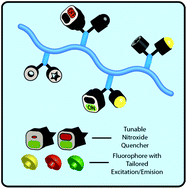Modular design of profluorescent polymer sensors†
Abstract
A simple modular strategy for the synthesis of profluorescent nitroxide containing polymers is described. The incorporation of an epoxide as a pendant functionality on a polymer backbone synthesized using ATRP and subsequent nucleophilic ring-opening with sodium azide gave hydroxyl and azide functionality within a 3-bond radius. Orthogonal coupling chemistry then allowed the independent attachment of fluorophore and nitroxide groups in close proximity, giving rise to a profluorescent polymer. Validation of the viability of these materials as fluorescent sensors is demonstrated through efficient fluorescence switch-on observed when the materials are exposed to a model reductant or carbon-centred radical source.


 Please wait while we load your content...
Please wait while we load your content...